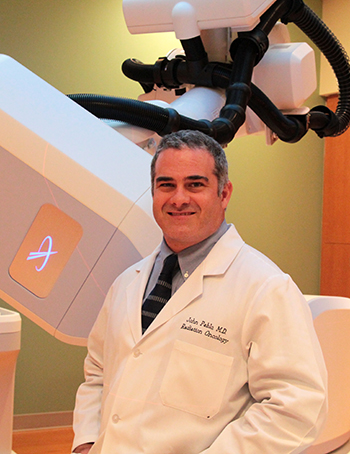How improvements in radiation therapy help treat breast cancer patients
Cancer
Radiation Oncologist Dr. John Pablo describes how a certain position and breathing technique can help protect other organs during radiation therapy for breast cancer
Breast cancer doesn’t discriminate. Anyone – female or male – can be diagnosed with breast cancer at any age.
But at the Nancy N. and J.C. Lewis Cancer & Research Pavilion, we treat each case individually to customize a treatment plan just for you. One such treatment option we may find best suited for you is radiation therapy using inspiratory breath-hold technique and prone positioning.
Breast cancer is a very common cancer in women, says Dr. John Pablo, radiation oncologist and medical director of the Radiation Oncology Center at the Lewis Cancer & Research Pavilion. One in eight women will be diagnosed with breast cancer over the course of a lifetime. Men can get breast cancer, too. One percent of all breast cancers are diagnosed in men.

The good news is that breast cancers can be found earlier thanks to the fact that advancements in screening diagnosis and treatment have greatly improved.
One treatment option for breast cancer is radiation therapy, an important component of a multidisciplinary process to optimally treat breast cancer, Dr. Pablo says. Approximately 70 percent of women with breast cancer undergo a surgical procedure called a lumpectomy, where the cancerous mass is removed, not the entire breast. Nearly all of those women will receive radiation following a lumpectomy, Dr. Pablo explains.
Approximately 30 percent of women with breast cancer undergo a mastectomy, a surgical procedure where the entire breast is removed. Twenty to 30 percent of those patients require radiotherapy following surgery, Dr. Pablo says.
Related Article: Understanding breast cancer treatment options
What is radiation therapy for breast cancer?
“Radiation therapy is treatment with photons (high energy x-rays), delivered by linear accelerator, a highly advanced radiation treatment machine,” describes Dr. Pablo. “The radiation energy that is aimed at the breast kills dividing tumor cells, which may be present even after surgery.”
When treating breast cancer, each treatment lasts approximately 15 minutes, and a typical course of radiation therapy varies between 15 to 30 sessions.
“Clinical studies (controlled randomized trials) have shown that in many patients with breast cancer the shorter course of treatment is equivalent to the longer course of treatment following lumpectomy,” Dr. Pablo says. “At the Nancy N. and J.C. Lewis Cancer & Research Pavilion, the shorter course of treatment is offered when indicated, so a patient's normal daily routines are disrupted as minimally as possible.”
Related Article: What can I expect from radiation therapy?
Radiation therapy has improved in recent years due to technological advances in the delivery of the radiation treatment, mostly due to improved computer speeds which allow for better imaging and treatment delivery from the machine, says. Dr. Pablo. In addition, integration of feedback on positioning back to the machine is achievable due to the newer technologies.
Positioning and treating breast cancer
Positioning is very important in the treatment of breast cancer, says Dr. Pablo. The treatment from the machine is custom tailored to a patient's body contour as well as the internal and external anatomy. It is important to avoid other organs and healthy tissues and cells while treating with radiotherapy, namely the heart and the lung.
Two strategies that are employed at the LCRP to diminish lung and heart dose are utilizing an inspiratory breath-hold technique and utilizing prone positioning. The inspiratory breath-hold technique utilizes technology in which the machine is only administering the treatment when the patient is comfortably holding their breath, explains Dr. Pablo.
“This allows for the lungs to expand so a smaller percentage of the lung is affected by the radiation. The expansion of the lung also pushes the heart away from the breast, so the heart in most cases is no longer affected by radiation treatment to the left breast.”
Using prone positioning, the patient lies on the table and gravity pulls the breast away from the lung and chest wall, says Dr. Pablo. This technique also allows for minimal amounts of radiation to the lung and heart.
These advances have greatly reduced side effects of radiation therapy to nearby organs and healthy tissue while being treated for breast cancer. However, some patients may still experience some side effects from radiation therapy.
“The main side effect that patients may experience from the course of radiation is a sunburn type reaction to the skin towards the end of the treatment,” Dr. Pablo says. “Generally, this heals up within a seven to 10-day time frame. There is also some fatigue associated with radiation treatments, but this varies from patient to patient.”
As many patients with breast cancer are treated with a combination of surgery, radiation therapy, chemotherapy, targeted therapy and/or endocrine therapy, having a treatment center with a multidisciplinary approach is highly beneficial, Dr. Pablo adds.
If you are diagnosed with breast cancer and are treated through St. Joseph’s/Candler, our clinical effectiveness team of surgeons dedicated to breast surgery, radiation oncologists, medical oncologists, genetic counselors, nurse navigators, along with access to clinical trials and other support staff, all work together to get you healthier sooner and with as few side effects as possible.